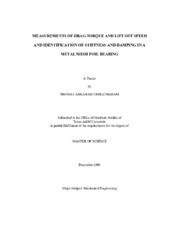| dc.description.abstract | Metal mesh foil bearings (MMFBs) are a promising low cost gas bearing technology
for support of high speed oil-free microturbomachinery. Elimination of complex oil
lubrication and sealing system by installing MMFBs in oil free rotating machinery offer
distinctive advantages such as reduced system overall weight, enhanced reliability at
high rotational speeds and extreme temperatures, and extended maintenance intervals
compared to conventional turbo machines. MMFBs for oil-free turbomachinery must
demonstrate adequate load capacity, reliable rotordynamic performance, and low
frictional losses in a high temperature environment.
The thesis presents the measurements of MMFB break-away torque, rotor lift off and
touchdown speeds, temperature at increasing static load conditions, and identified
stiffness and equivalent viscous damping coefficients. The experiments, conducted in a
test rig driven by an automotive turbocharger turbine, demonstrate the airborne operation
(hydrodynamic gas film) of the floating test MMFB with little frictional loses at
increasing loads. The measured drag torque peaks when the rotor starts and stops, and
drops significantly once the bearing is airborne. The estimated rotor speed for lift-off
increases linearly with increasing applied loads. During continuous operation, the
MMFB temperature measured at one end of the back surface of the top foil increases
both with rotor speed and static load. Nonetheless, the temperature rise is only nominal
ensuring reliable bearing performance. Application of a sacrificial layer of solid
lubricant on the top foil surface aids to reduce the rotor break-away torque. The
measurements give confidence on this simple bearing technology for ready application
into oil-free turbomachinery.
Impact loads delivered (with a soft tip) to the test bearing, while resting on the
(stationary) drive shaft, evidence a system with large damping and a structural stiffness
that increases with frequency (max. 200 Hz). The system equivalent viscous damping
ratio decreases from ~ 0.7 to 0.2 as the frequency increases. In general, the viscous
damping in a metal mesh structure is of structural type and inversely proportional to the
frequency and amplitude of bearing motion relative to the shaft. Impact load tests,
conducted while the shaft rotates at 50 krpm, show that the bearing direct stiffness is
lower (~25% at 200 Hz) than the bearing structural stiffness identified from impact load
tests without shaft rotation. However, the identified equivalent viscous damping
coefficients from tests with and without shaft rotation are nearly identical.
The orbits of bearing motion relative to the rotating shaft show subsynchronous
motion amplitudes and also backward synchronous whirl. The subsynchronous vibration
amplitudes are locked at a frequency, nearly identical to a rotor natural frequency. A
backward synchronous whirl occurs while the rotor speed is between any two natural
frequencies, arising due to bearing stiffness asymmetry. | en |


